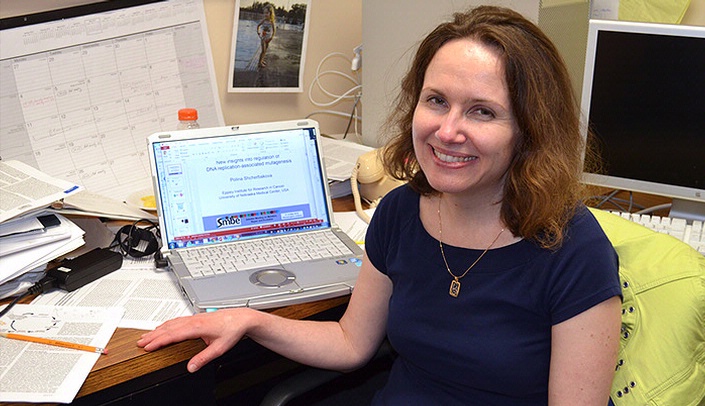Every great publication, like this one, has a strict proofreader who catches mistakes before the story goes out. Still, misatkes are made. (Oops!)
Cells in our body work the same way. Each time a cell divides, the DNA is replicated in an exceptionally flawless process with the help of an exonucleolytic proofreader that works with DNA mismatch repair (MMR) machinery to correct the mistakes.
DNA is repeatedly replicated and repaired, but bits and pieces of its sequences also are perpetually changed, misplaced and swapped – a process that produces mutations. Still, only one mutation gets through for every one billion nucleotides. Basically, every time a cell divides, one mutation occurs in the human body. That’s normal.
In contrast, the rate of mutation in cancer cells is much higher. The most hyper-mutated colorectal and endometrial tumors in humans can carry as many as 250,000 mutations.
These hyper-mutated tumors carry mutations in the replicative DNA polymerase genes that disrupt the fidelity mechanisms. How exactly they do this is unclear.
For the past 25 years, Polina Shcherbakova, Ph.D., associate professor, Eppley Institute, has studied the mechanisms of mutagenesis associated with DNA polymerase infidelity. She uses a yeast model to create the same DNA polymerase mutations seen in humans and decipher the mechanism of their action.
In collaboration with colleagues from Umeå University, Sweden, she recently published a paper in PNAS that describes a "previously unappreciated pathway" triggered by a colon cancer-associated DNA polymerase mutation. Dr. Shcherbakova found that the erroneous DNA synthesis by the polymerase variant, or proofreader, induces checkpoint-dependent expansion of pools of DNA precursors. This increase, in turn, causes further dramatic reduction in the fidelity of the polymerase, resulting in more errors and continuous activation of the signaling cascade that keeps the precursor pools expanded. It becomes a vicious circle.
"This phenomenon may provide insight into the processes shaping the genomes of hypermutated human cancers," Dr. Shcherbakova said.
While these mutations are only seen in 3 percent of colorectal cancer and 8 percent of endometrial cancer, the research has broad significance, Dr. Shcherbakova said.
"These numbers represent 10,000 cases a year," she said.
In 2013, a new cancer syndrome also was described in which people who were born with mutations in their DNA polymerase genes begin to develop cancer by their 20s. Somatic DNA polymerase mutations also are seen in other cancers – gastric, breast and childhood cancers, especially brain tumors in children who are born with defects in DNA mismatch repair. After a few years, somatic mutations in DNA polymerase genes accumulate, and brain or other cancers develop.
Back in 1974, Lawrence Loeb, M.D., Ph.D., professor of biochemistry, University of Washington School of Medicine, Seattle, introduced the concept that cancers express a mutator phenotype, which accounts for the disparity between low mutation rates in normal cells and the large rate of mutations present in many human tumors.
"The discovery of replicative DNA polymerase mutations in cancers is a beautiful confirmation of these ideas," Dr. Shcherbakova said.
The next challenge is to stop the mutations from happening in the first place. "Mutator polymerases are very sensitive to nucleotide levels. If they don’t have enough, they don’t make mutations.
If they have too much, the cells die due to excessive levels of mutagenesis," she said. "Normal cells are not as sensitive to varying levels of nucleotides."
Mutations in our DNA also occur because of environmental influences, like the sun. Dr. Shcherbakova’s other research focuses on exposure-induced damage, for which she has a five-year, $1.1 million grant from the National Institutes of Health that is now in its second round. She also receives funding from LB506, the Cancer and Smoking Disease Research Fund administered by the Nebraska Department of Health and Human Services.
"Nucleotide pools determine the level of mutagenesis, so we need to know more about the mechanism in order to design therapeutics in the future."
Web extras
Read Dr. Shcherbakova’s article in PNAS.
